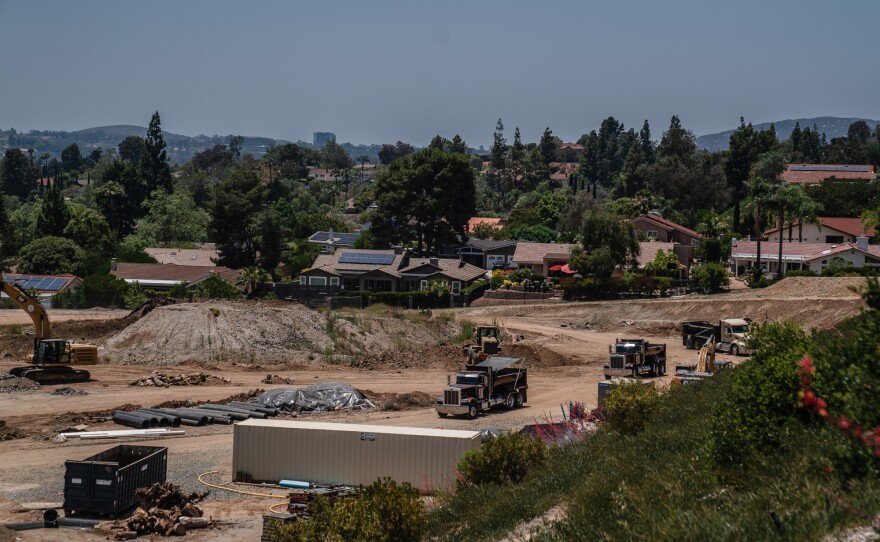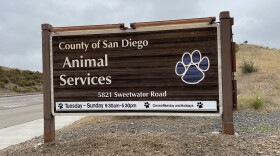The city of Poway is a haven for single-family homes, known for its exclusivity. Picture tree-lined streets, sprawling manicured lawns and long driveways. It is a dream within the American Dream.
Much of Poway’s land is made up of larger lots, each zoned for a single home instead of multi-family homes like apartment complexes or townhomes.
And outside those single-family-home neighborhoods, the land is also protected from development. Roughly 53 percent of Poway is protected open space, according to city officials.
Those factors at least help to explain why Poway is among cities building the least amount of housing per capita, an analysis by Voice of San Diego found. Between 2018 and the end of 2024, Poway permitted 14.1 new homes for every 1,000 residents, including apartments, single-family homes and accessory dwelling units. Just three cities, Lemon Grove, Imperial Beach and El Cajon, permitted less homes per capita than Poway during those six years.
Some estimates place Poway’s level of single-family zoning on a truly incredible scale.
The Othering and Belonging Institute at the University of California, Berkeley found that roughly 98 percent of Poway is zoned for single-family homes. That would be the highest percentage of single-family zoning in the entire county.

There are other cities with high percentages of single-family zoning, according to Berkeley’s analysis, like Encinitas and Lemon Grove, which both have 95 percent of their residential land zoned for single-family homes.
But Poway’s development services director, Julie Procopio, challenged the Berkeley map.
She told Voice of San Diego that, yes, Poway does have a lot of single-family zoning, but not quite as much as the Berkeley map shows.
First of all, Procopio said, the map doesn’t appear to take into account the Poway Road Specific Plan, a multi-year effort by the city to make way for multi-family homes, retail spaces, office spaces and a mix of all three.
The area includes a 2.65 mile stretch of Poway Road. The goal of the plan is to create a town center with spaces for events, public spaces and amenities, outdoor dining, opportunities for small businesses and residential housing.
The Berkeley map shows much of the Poway Road area as “non-residential/unknown,” but multi-family units have already been built and more are under construction, Procopio said.
“Maybe because so much of our higher density residential homes are along Poway Road, it likely skews the results a bit,” Procopio said.
Poway has a lot of single-family zoning, but it’s also worth pointing out that the city is zoned for very large lot sizes in some places. Large lot sizes make it harder to build with even modest density.
Some lots in Poway have a minimum size of an acre. Others have a minimum size of 20,000, 15,000 and 10,000 sq. ft.
In the city of San Diego, 5,000 sq ft. is the typical minimum lot size.
Protected open space
Single-family zoning isn’t the only factor at work when it comes to Poway’s low housing numbers.
The city also has large plots of vacant land that are designated open space areas. A whopping 53 percent of Poway’s land is within a special area set aside for environmental protection or conservation, called the mitigation boundary, Procopio said.
That mitigation boundary, which mostly runs from north to south along the city’s eastern border, was established by state and federal wildlife agencies that guide how the land can be used.

In 1996, Poway entered into agreements with the U.S. Fish and Wildlife Service and the California Department of Fish and Wildlife and created a habitat conservation plan to help conserve some of the sensitive and endangered habitats in the city, while still allowing for some level of development.
The conservation efforts are to protect coastal sage scrub, an endangered habitat, with large portions across the state being lost due to development. These habitats also support animals like the California gnatcatcher, a type of small bird that’s categorized as “federally threatened” by the U.S. Fish and Wildlife Service.
Most of the land within the mitigation boundary must be preserved as open space. In some cases, the city can allow very low-density rural development in portions of these open space areas, but only up to 2 acres of each rural lot can be developed or disturbed, Procopio said. These rural lots can each span upwards of 20 acres. Multi-family developments or zoning changes within this boundary are prohibited by these agencies.
“It really governs how we develop in natural areas, and it limits the density that we can develop at,” Procopio said. “There are areas we just can’t develop on. And any time we do impact habitat it has to be mitigated at 2 to 1, which means any impact results in twice as much conservation.”
Procopio also explained that some of the single-family zoning areas shown on the map overlap with some of the city’s designated open space areas. And in some cases, an area of the city may be zoned as single-family, but in reality, the land is too steep to build on.
What about Poway’s housing goals?
With less developable land than many other cities, and single-family zoning covering most of what’s available, Poway is building new housing at one of the slowest rates in San Diego County.
Between 2018 and 2024, Poway issued just 14.1 housing permits per 1,000 residents — the fourth-lowest rate in the County. And most of those weren’t for larger-scale projects.
“The lion’s share of our activity is individuals building ADUs on their own property, or individuals building single family homes on a lot,” Procopio told Voice back in June.
Still, the city is technically in compliance with state housing laws, which require cities to update their zoning plans to accommodate new housing, and officials aren’t planning to make any major zoning changes.
In theory, a development with affordable housing can use the state’s density bonus law to build more units than zoning typically allows — including on single-family lots. And if a developer wanted to rezone single-family land for multi-family housing without including affordable units, that request would go to the City Council. But Procopio said those kinds of proposals rarely come forward.
Procopio told Voice that Poway has already identified enough sites, or parcels of land, for the different types of housing the city needs to meet its housing goals.
“As part of the [state’s housing] process, we identified Poway Road as where we have capacity for more housing because there aren’t sensitive habitats there,” she said. “We still have developable multi-family zoning on that corridor, so that still has a lot of additional capacity.”
Procopio said Poway worked closely with the state housing department to get its Housing Element — the city’s long-term housing plan — approved. And so far, the state hasn’t pushed Poway to change its zoning, unlike in other cities such as Encinitas.
“It’s hard to compare jurisdictions because we’re so geographically diverse,” Procopio said. “When it comes to Poway, [the housing department] and all of the state regulations really encourage development to happen in the urban core and not in sensitive habitat areas, so we are consistent with what these wildlife agencies are looking for.”
She added that Poway’s housing numbers are “pretty impressive compared to the overall capacity Poway has.”













